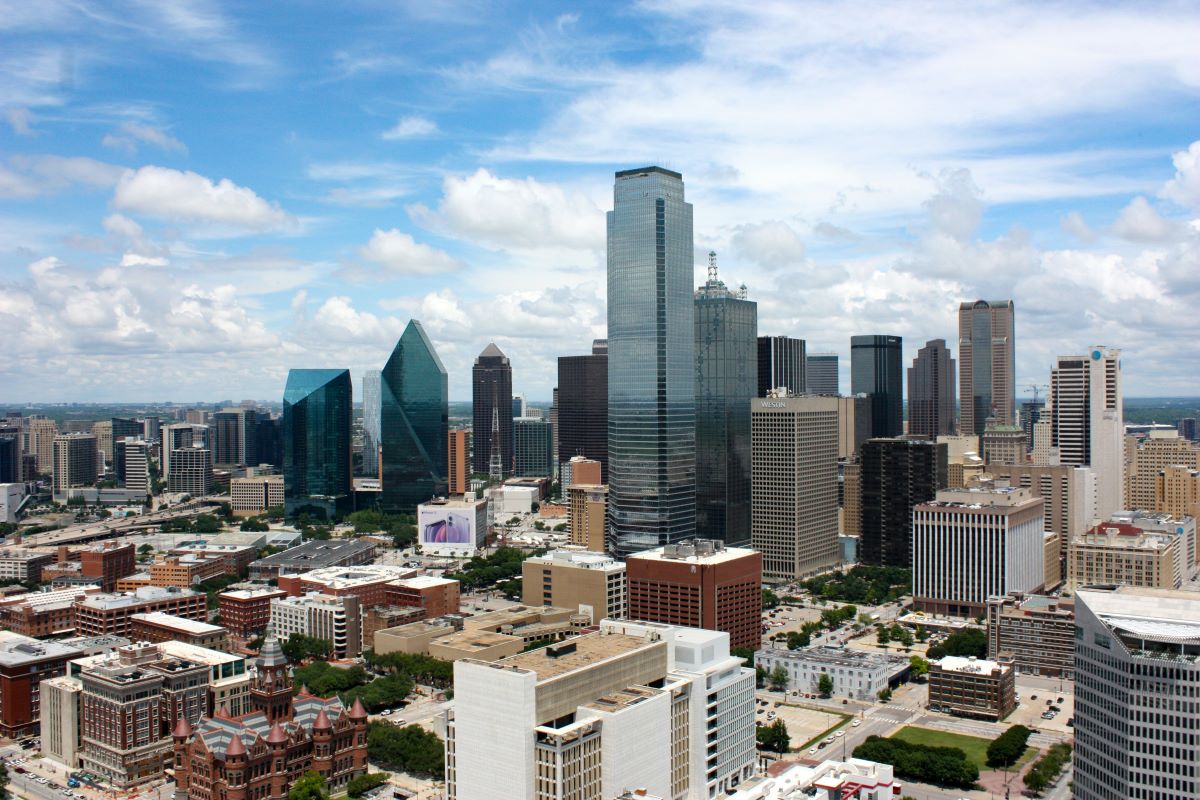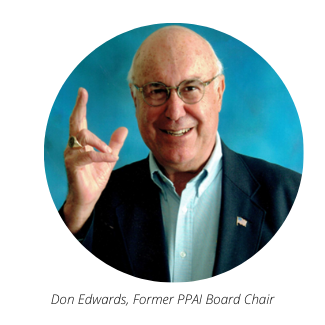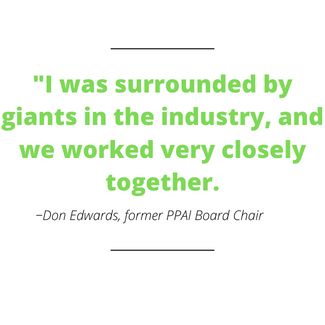How Did PPAI End Up In Texas, Anyway?

Don Edwards has a slogan that he applies to challenges, and he still lives by it at 91 years old.
“If it can’t be done, it interests me.”
Edwards is the oldest living former chair of the PPAI Board, and when he presided over the Association in 1978, he faced the type of challenge that compelled him throughout his career: Moving PPAI from Chicago to Texas.
That career dates all the way back to 1962 when he founded Don Edwards Marketing, which he was ran for the next 25 years. But his company’s success over that time is only a part of what Edwards accomplished in and out of the promotional products industry.
A veteran of the Korean War, Edwards used the G.I. Bill to get his bachelor’s degree and master’s in marketing. He served on PPAI’s board from 1974 until being named chair in 1978. At that time, PPAI was still referred to as Specialty Advertising Association International. Among many other awards and acknowledgments, Edwards was inducted into the PPAI Hall of Fame in 1989.
But it was 44 years ago when he and the PPAI board oversaw a transition that would have huge implications for the future of the Association and the industry.
Why The Relocation?
When Edwards was named chair of PPAI’s board, the Association’s headquarters were located at 740 Rush Street in downtown Chicago, a vibrant area long established as a center of business. But the city’s weather wasn’t always conducive to employees or visitors.
“The winters could be bad there, and there were times when people had trouble even getting into the office on the worst days,” Edwards says.
This was 44 years ago, well before the recent rise in work-from-home capabilities and before e-mail made in-person interactions essential.
The Association needed more office space and was already paying high rent prices in Chicago. So an idea was raised: What if the Association owned its own building?
“A Challenging And Exciting Time”

Edwards stepped into his position as chair of PPAI during what he called a “challenging and exciting time.” There was a plan to relocate headquarters, which would involve the construction of a new building. But looming over all of this was the retirement of Association President Bob Rollings, who had seen the Association through mergers and successful years. The intended successor for Rollings did not work out, and Edwards and the board were forced to scramble to hire the right replacement.
The Association was also in its 75th year of existence and planning for a commemoration was a time-consuming process that was important to many.
It was a lot for the Association to take on, but Edwards leaned on the support and knowledge of his board, and would later say, “I was surrounded by giants in the industry , and we worked very closely together.”
Eventually the decision was made to appoint Ted Olson, who worked in tandem with Edwards to facilitate key parts of the move to Texas.
“The Growth And Potential For Dallas Was Really Great”
According to Edwards, no other cities outside of the Dallas-Fort Worth area were seriously considered. The board met with economic developers from Dallas, which confirmed much of what they had believed: Dallas and its surrounding cities were primed for an economic boom. DFW International Airport had opened for commercial service in the mid-70s.
“The growth and potential for Dallas was really great,” Edwards says.
Property was acquired on a range land parcel of the Hackberry Creek Ranch in Irving, Texas.
Sure enough, Dallas would come to represent (with the help of the popular television show named after it) the country’s economic prosperity in the 1980s.
Chicago fire marshals had begun restricting the Association’s summer and winter trade shows from being held in the hotels where they had previously been held. In Texas, trade shows could be held at the Dallas Convention Center (later renamed the Kay Bailey Hutchinson Convention Center), which hosted The PPAI Expo until the event moved to Mandalay Bay Convention Center in Las Vegas in 2003.
It seemed like the perfect region for an association to headquarter.
“You know, even Boy Scouts International, which was headquartered in New Jersey, moved [to Irving] and they built their building right across the street from where we had our building,” Edwards says.
Initial Setbacks
Edwards remembers that while there was plenty of prime land to be had in North Texas, the land was not exactly stable—literally. The ground where the Association had intended to headquarter had begun to shift in the soft North Texas soil, which would cause leaking.
The Association was able to negotiate out of that building and complete the move to its new headquarters (with stable ground) in September 1979.
 It was a tumultuous time to make a major move, but the Association pulled it off, and Edwards attributed the success again to the board members, as well as Olson, humbly passing on any credit for himself. He still recalls a lesson he learned in college when a professor told him the difference between a leader and a manager.
It was a tumultuous time to make a major move, but the Association pulled it off, and Edwards attributed the success again to the board members, as well as Olson, humbly passing on any credit for himself. He still recalls a lesson he learned in college when a professor told him the difference between a leader and a manager.
“A leader does the right thing,” Edwards says. “A manager does things right.”
Positioning the Association for its future required looking forward and doing the right thing time and time again.
Heading To The White House
After the Association had completed its move to the new Texas headquarters and Edwards wrapped up his term as chair, he would take on another very special role. During the Reagan administration, he served an 18-month term as commissioner of education and training for the White House Conference on Small Business.
There was a growing notion that, in order for small businesses to thrive in the U.S., it was important for kids, even as early as elementary school, to have some basic understanding of how business works on a small but meaningful scale. Edwards helped develop a program while working with the White House called the School To Work program which provided education to children in matters of small business.
Edwards’ Lasting Dream
Education being a passion of Edwards, one dream that he always had for the Association’s Texas headquarters was a promotional products museum. The industry had provided great careers for Edwards and so many others, but it had also helped so many small and large businesses get their names and products in front pf people. The history and evolution of the promotional products industry is in itself an archive of effective marketing. Edwards imagined marketing students from surrounding universities could visit and perhaps even tourists.
Eventually Richard Ebel would manifest a small version of that dream in the PPAI lobby, which showcases promotional products from generations past encased in glass, some dating back to the 1800s.
Those little artifacts represent the history of promotional products, but where they reside, and PPAI’s footprint in North Texas is its own testament to the legacy of Don Edwards.

